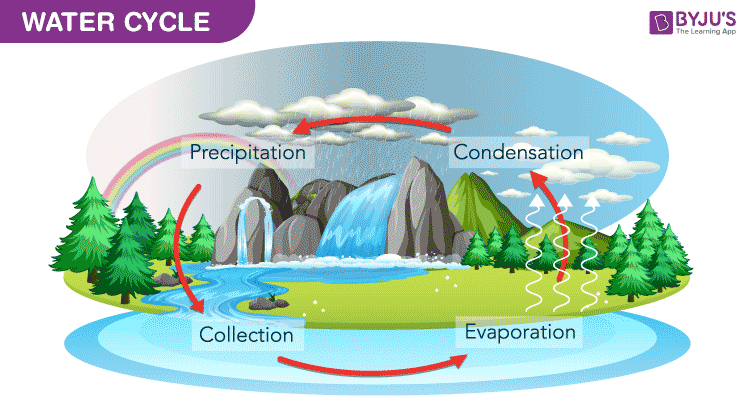Table of Contents
Water is a precious natural resource of our planet earth. It cannot be created or destroyed. The water on the earth today is the same water that existed thousands of years ago and will continue to exist years in the future.
What is the Water Cycle?
The water cycle is an important Biogeochemical Cycle involved in the flow or circulation of water through different levels of the ecosystem. The water cycle is defined as a natural process of constantly recycling the water in the atmosphere. It is also known as the hydrological cycle or the hydrologic cycle.
During the process of the water cycle between the earth and the atmosphere, water changes into three states of matter – solid, liquid and gas.
The diagram of the water cycle is useful for both Class 9 and 10. It is one of the few important topics which are repetitively asked in the board examinations. Below is a well labelled and easy diagram of water cycle for your better understanding.
Diagram Of Water Cycle

Stages of Water Cycle
The complete water cycle is carried into four stages which are as follows: Evaporation, Condensation, Precipitation and Collection.
Evaporation
This is the initial stage of the water cycle.
The process by which water from its liquid state changes to vapour, a gaseous state, is termed as evaporation. During the water cycle, water in the water bodies get heated up and evaporates in the form of vapour, mixes with the air and disappears.
Condensation
When the evaporated water vapour loses its thermal energy, it becomes liquid through the process of condensation. Formation of clouds are examples of condensation.
Precipitation
Rain, snow, sleet, or hail are all examples of Precipitation. After the condensation, atmospheric water vapour forms sufficiently large water droplets and falls back to the earth with the help of gravity.
Deposition or Collection
This is the final stage of the water cycle. Deposition occurs when evaporated water vapour falls back to earth as precipitation. This water may fall back into the different water bodies, including oceans, rivers, ponds, lakes and even end up on the land, which in turn becomes a part of the groundwater.
Overall, the water cycle process describes how water is balanced in the atmosphere. It also plays an important role in ensuring the availability of water for all living organisms and also it has a great impact on our environment.
For more information about Water Cycle, its steps, facts and other related topics, visit us at BYJU’S Biology.
Thanks for your help
Thanks for your help Byjus always helps my children to understand thank u very much
Thank you! This helped so much!
Thanks a lot! This helped in my project!
It’s very helpful